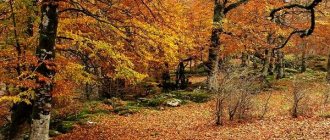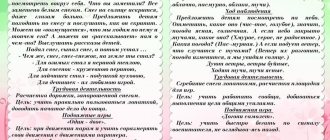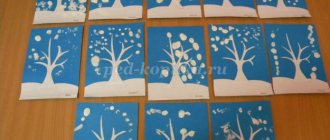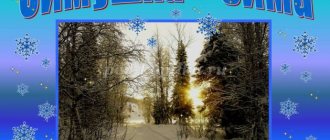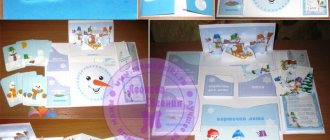Labor activity during a winter walk.
“The place and significance of labor on a winter walk.”
(consultation)
Work is of great importance in raising children. One of the types of work activity in kindergarten is work on a winter walk.
The desire to participate in work activities is cultivated from the younger group. The teacher brings out shovels and brooms, and offers to clear the snow from the paths together with the teacher and spread it with a broom. You can suggest making a small slide for dolls to ride on. The children, together with the teacher, carry snow on a sled, pat it down with a shovel, and with the help of the teacher make a small slide. Sliding dolls down a hill on a toy sled will bring great joy to children. On warm days, the teacher organizes snow modeling, gives molds and shovels. Children will learn that snow can be sculpted. We need to show how to roll small balls and make a snowman, how to make snowballs. With the help of a teacher, the kids feed the birds.
Children in the middle group can take a more active part in clearing the area of snow. The teacher teaches them how to shovel snow on the paths. Children load the sleds and carry the snow under the trees and bushes, dumping them into piles for play. On the site, with the help of a teacher, they feed the birds.
In the older group, the range of work responsibilities expands even further, children are accustomed to more complex forms of activity. In older groups, labor should occupy a significant place during the walk. Children can actively participate in the construction of complex buildings (snow bank, slide, ice path, snow house), as well as in clearing the area of snow and decorating it. Children should be taught some techniques for working with snow: rolling a snowball, cutting bricks from compacted snow with a shovel, making simple buildings out of them, raking snow with a shovel, sweeping it with a broom. It would be good if cleaning the area becomes a permanent responsibility for the children. To do this, you need to establish a sequence. After a snowfall, you can organize a collective cleaning of the area from snow: some children shovel the snow, others take it away on sleds, and someone sweeps it away with a broom. Children can participate in the preparation of colored ice floes: put colored snow in metal molds and tip them over. Children, under the guidance of a teacher, use ice flakes to decorate snow beds, buildings, etc. In the process of work, the teacher draws children's attention to the properties of snow in different weather: children learn that in warm weather snow molds well, but in severe frost it crumbles.
After a snowstorm, draw the children’s attention to the snow cover, talk about its importance in the life of plants in winter, therefore, when cleaning the area, the children take it to the trees and shrubs. The teacher teaches them to hill up trees and make high snow mounds around them, which better protects the roots from frost. This provides more moisture in the spring and protects the trees from sunburn. Children learn that too much snow can damage a tree. After heavy snowfalls, under the weight of the snow, the branches may break, so the snow must be shaken off the branches, i.e. During labor on a winter walk, an active cognitive process takes place.
Children of older groups already feed the birds themselves, without the help of a teacher. When feeding wintering birds, children's ideas about these birds, their habits, and nutrition are clarified. Children observe which birds come regularly, which ones rarely, and which ones they like to feed more. If the birds are not fed, they will peck the buds of fruit trees and, instead of doing good, will cause harm.
In the process of working while walking, children, under the guidance of a teacher, master a number of skills, learn to compare and generalize observations, understanding some of the dependencies between them. Children develop curiosity and observation. The ability to think independently. In work, the formation of the moral aspects of the individual is of greatest importance. In work, they learn to kindly negotiate with each other about the distribution of responsibilities and equipment, and learn to help each other if someone is tired or cannot cope. A sense of responsibility for the assigned work is fostered, a desire to persistently achieve results, and bring the matter to the end. The desire to take up work of one’s own free will develops, and not just at the suggestion of the teacher, and respect for work is cultivated.
During work, the child faces stress, especially during a winter walk when clearing snow. The teacher must ensure that there is no overload. Overload causes children to quickly become tired, which is why they develop a negative attitude towards work or refuse to complete it. Rapid breathing, sweating, redness of the face are signs of overload, so the teacher must stop the child and offer him another, calm type of activity.
Winter work brings children a lot of joy, promotes health, helps expand their understanding of the properties of snow and ice, and fosters a love of nature.
Entertainment for middle-aged children “Journey to the Winter Forest”
"Walk in the Winter Forest"
Subject:
Winter-winter
Program content Objectives: Educational
To consolidate ideas about the characteristic signs of winter, about the state of living and inanimate nature, broaden the horizons of children, stimulate cognitive interest.
Developmental
Develop communication skills, dialogical speech.
Educational:
To cultivate a caring attitude towards nature
Vocabulary work:
light, joyful, snowy, fluffy, winter.
Preliminary work:
conversation about the signs of winter, looking at illustrations.
Materials and equipment:
illustrations of winter landscapes, reference diagrams of winter signs, models for generalizing external signs, living conditions of a hare, educational game “animals”, snowflakes, a hoop (lined with tinsel), snowballs.
laptop, musical compositions. Methodology
Stages Contents Note
Introductory part Educator:
- Hello, golden sun!
Hello, blue sky, Hello, free breeze, Hello, little white snow! Hello, kids: girls and boys, Hello, I’ll tell you a riddle! - It's getting cold. The water turned into ice. The long-eared gray bunny turned into a white bunny. The bear stopped roaring: The bear fell into hibernation in the forest. Who can say, who knows, When this happens? Children:
In winter - That's right, in winter. Here I am, Winter Winter, I have come to visit you. And I brought snow with me. A teacher in a winter suit enters the group (establishing emotional contact). Main part - Now I will share with you particles of snow
gazprombank.ru
- Let's stand in a circle and turn into snowflakes. And we’ll spin around as if we were light, fluffy, weightless. Educator:
- Guys, have you heard what a beautiful, magical, wonderful melody sounded just now, but how else can you say about it?
What is she like? Children:
Winter, snowy
Educator:
That's right, and it's also light and joyful - Guys, sit down in your seats.
What joys does winter bring you? What do you like to do in winter? Children:
Walk, build a snowman, sledding.
Teacher:
- And now I invite you to the winter forest.
And this magical cloud will help us get there. Educator:
Let's all stand around our cloud together and go into the winter forest, and this magic wand will help us transport ourselves to a forest clearing.
Let's fly Teacher:
- Here we are in a forest clearing.
3. CONVERSATION “SIGNS OF WINTER IN NON-LIVING AND NATURAL NATURE” Educator:
- Sit down in the clearing Guys, tell me what happens in nature in winter?
What changed? I have these magical pictures that will help you. Educator:
- Does snow fall in winter?
What do we see in this picture? What happens in nature? Children:
it’s snowing
Teacher:
- The rivers are covered with ice.
What happened to the river in this picture? - The sun is shining, but it does not warm. What kind of sun do we have in winter? The sun is shining, but the snow is not melting, why? Educator:
The sun doesn’t heat as much as in summer and that’s why the snow doesn’t melt in winter - Trees without leaves.
There are fewer birds. Educator:
Birds fly to warm countries for the winter, and arrive only when winter recedes and the snow melts
Educator:
- What good fellows you are!
You know so much about winter. Now put the snowflakes in a magic box and let's see what happens to them. One, two, three - look, our snowflakes have turned into snowballs. Let's collect them all into one big snowdrift Educator:
Well done, look at what a beautiful snow-white snowdrift we have, and now we need to sit down at the tables. Guess the riddle, who was hiding under the tree?
- In summer, a gray fur coat, and in winter, white. He wears a timid little jumper....... Children: hare Teacher:
- Now let’s tell you about the hare, and the pictures will help us.
-Where does the hare live? And Seryozha will choose the right picture and show the children - What does a hare look like? -What does it eat? — How does it adapt to winter? DIDACTIC GAME “BEASTS” Educator:
- Now we will play a game.
What forest animals do you know? (children's answers) - Pick up only the animal of the forest. And show it to me How did you guess that this animal lives in the forest? Educator:
Well done, the guys all completed the task. I hand out snowflakes. The children stand in a circle and spin around. The audio recording “Silver snowflakes” plays. I listen to all the children’s answers. On the carpet lies a cloud cut out of whatman paper. Children stand around it. I wave a magic wand, music sounds. Children sit on the carpet.
I talk with the children. I show the children one by one pictures for the correct answers. I give snowflakes. I quietly change the boxes. In the box there is cotton wool in the form of snowballs. Children take turns putting snowballs (cotton wool) into one large snowdrift. Children sit at the tables. Make a riddle. Show me a toy - a hare. Children go out and show the desired picture. I conduct a didactic game. On the table, each child has 2 pictures: one of a forest animal, one of a domestic one. The children are prompted to answer by the image of an animal and the forest around it. Final part. Educator:
This is where our journey ends. Let’s stand around the cloud again and find ourselves in kindergarten
Teacher:
- Today, we visited the winter forest, remembered what happens in winter, talked about the bunny and helped the forest inhabitants.
- For me Zimushka - it’s time for winter to leave. As a parting gift, I will give you snowflakes. So that you do not forget winter and remember its signs. I summarize the lesson
I give snowflakes to the children Children stand around the cloud and return to the group
